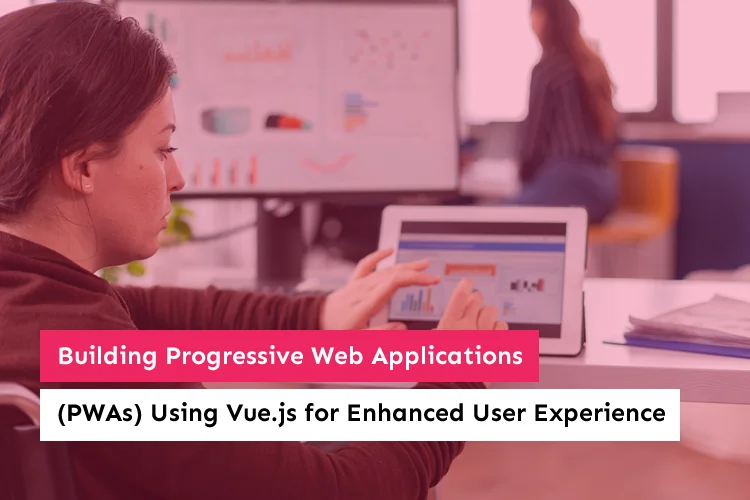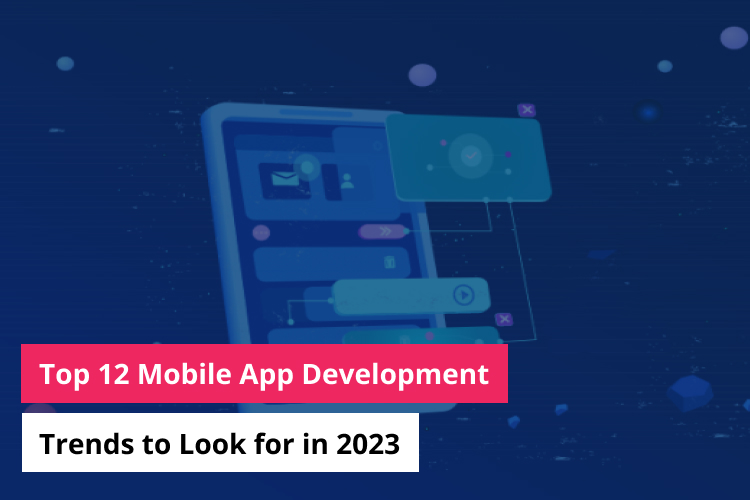Building Progressive Web Applications (PWAs) Using Vue.js for Enhanced User Experience

Are You Ready to Transform Your Website into an Unforgettable Experience?
In a world where user attention spans are fleeting and the demand for exceptional digital experiences is ever-growing, a burning question lingers in the minds of web developers and businesses alike:
“How can we captivate our audience and provide a browsing experience that leaves them wanting more?”
If you find yourself pondering this very question, fret not, for you are about to embark on a journey that promises to revolutionize your approach to web development. Welcome to a realm where the power of Progressive Web Applications (PWAs) intersects with the elegance of Vue.js development, an ingenious JavaScript framework.
In this blog, we unveil the secret formula that empowers you to not just meet but exceed the expectations of your users – all through the creation of seamless, fast-loading, and enchanting PWAs with Vuejs magic.
So, fasten your seatbelts, as we dive into the world of PWAs and discover how Vue.js can be the catalyst for transforming your website into an unforgettable digital wonderland. Ready to embark on this adventure? Let’s get started.
Understanding Progressive Web Applications (PWAs)
In a world where users demand fast, reliable, and engaging digital experiences, Progressive Web Applications (PWAs) have emerged as a groundbreaking solution that bridges the gap between traditional websites and native mobile applications. A PWA represents a new era in web development, combining the best features of both worlds to deliver a seamless, high-performance user experience. Let’s delve deeper into the fundamental aspects of PWAs and why they are reshaping the digital landscape.
The Evolution of Web Applications
Traditionally, web applications have been confined to the browser, limited by their dependence on network connectivity and constrained interactivity. Native mobile applications, on the other hand, offer impressive performance and user engagement but come with the hassle of app store distribution and frequent updates. PWAs emerged as a response to these limitations, aiming to create a harmonious blend of the web’s accessibility and native apps’ capabilities.
Key Characteristics of PWAs

Progressive Enhancement
As the name suggests, PWAs embrace the principle of “progressive enhancement.” They are designed to work seamlessly across a range of devices and browsers, adapting to the capabilities of each platform while ensuring a consistent user experience. Whether users access the PWA on a cutting-edge desktop browser or a modest smartphone, they can expect a functional and visually appealing encounter.
Responsive Design
A hallmark of modern web development, responsive design is integral to PWAs. These applications are crafted to fluidly adapt to various screen sizes and orientations, guaranteeing a consistent layout and usability on devices ranging from smartphones and tablets to desktops.
Fast Loading Times
PWAs are engineered with performance in mind. They leverage techniques like code splitting, lazy loading, and efficient caching to ensure rapid loading times. This swift loading not only enhances user satisfaction but also plays a crucial role in search engine rankings.
Offline Functionality
Perhaps one of the most revolutionary aspects of PWAs is their ability to operate offline or in low-network conditions. This is made possible by the integration of service workers, who act as intermediaries between the PWA and the network, enabling the app to cache essential assets and data for offline use.
App-Like Experience
PWAs strive to deliver an app-like experience within the confines of a browser. This encompasses smooth animations, gestures, and interactions that mimic the behavior of native applications. Users can expect a familiar and immersive encounter, fostering engagement and user retention.
Home Screen Installation
PWAs offer users the option to add them to their device’s home screen, blurring the line between web and native apps. This eliminates the need for downloading and installing apps from app stores, streamlining the process and reducing friction for users.
What are the Benefits of PWAs?
- Cost-Effectiveness: Developing a PWA eliminates the need for separate development efforts for various platforms (iOS, Android, web), leading to significant cost savings.
- Broader Reach: PWAs are accessible via URLs and can be shared through links, enabling wider distribution and eliminating the need for app store approvals.
- Improved SEO: Due to their fast loading times and responsive design, PWAs often rank higher in search engine results, leading to increased organic traffic.
- Engagement and Retention: The enhanced user experience offered by PWAs, coupled with features like offline access, contributes to higher user engagement and longer session durations.
- Faster Updates: Developers can push updates directly to users without the need for app store approval processes, ensuring that users always have access to the latest version.
PWAs with Vuejs : A Powerful Framework

When it comes to building Progressive Web Applications (PWAs) that offer enhanced user experiences, the choice of framework plays a crucial role. Vue.js, a modern and versatile JavaScript framework, has gained immense popularity for its simplicity, flexibility, and efficiency. Let’s delve into why Vue.js is an exceptional choice for creating PWAs that deliver outstanding user experiences.
Reactivity and Component-Based Architecture
At the core of Vue.js is its reactive data binding system, which allows developers to build dynamic and interactive user interfaces with ease. This reactivity empowers developers to create PWAs that respond instantly to changes in data, providing a seamless and engaging user experience. Vue.js’s reactivity simplifies the process of updating the UI, making it an ideal framework for crafting the real-time interactions that PWAs require.
Furthermore, Vue.js promotes a component-based architecture, enabling developers to break down complex UIs into manageable, reusable components. This modular approach not only enhances code maintainability but also aligns perfectly with the principles of PWAs, where components can be optimized and reused across various sections of the application.
Vue Router and Single-Page Applications
The Vue Router, an official Vue.js routing library, allows developers to create single-page applications (SPAs) with smooth and dynamic navigation. SPAs are a key aspect of modern web development and are well-suited for PWAs. With Vue Router, developers can create seamless transitions between different views without the need for full-page reloads, mimicking the experience of native mobile apps.
For PWAs, where smooth navigation and transitions are paramount, Vue Router provides the tools needed to build intuitive and responsive user interfaces.
Vuex State Management
PWAs often require efficient state management to handle complex data flows and ensure a consistent user experience. Vue.js offers Vuex, a state management library that integrates seamlessly with Vue applications. Vuex provides a centralized store where application data can be managed, shared, and mutated in a predictable manner.
For PWAs, Vuex plays a critical role in maintaining a coherent state across various components and views. This is particularly beneficial when dealing with offline caching, user authentication, and handling asynchronous data fetching.
Performance Optimization
Performance is a top priority in the world of PWAs. Vue.js, known for its lightweight nature, offers various tools and techniques for optimizing the performance of your application. Through features like lazy loading, asynchronous component loading, and code splitting, Vue.js helps ensure that only the necessary assets are loaded, leading to faster initial load times and improved overall performance.
Additionally, Vue.js’s virtual DOM implementation minimizes unnecessary re-renders, further contributing to efficient rendering and reduced resource consumption.
Service Workers Integration
Service workers are a cornerstone of PWAs, enabling features like offline access and background syncing. Vue.js, through Vue CLI, provides seamless integration of service workers into your PWA project. Service workers act as intermediaries between the application, the network, and the browser cache, enabling advanced caching strategies and offline functionality.
By leveraging Vue CLI’s built-in service worker support, developers can easily configure caching strategies, precaching assets, and even handle push notifications, creating a more reliable and engaging user experience.
Steps to Build PWAs with Vuejs for Enhanced User Experience
Progressive Web Applications (PWAs) built using Vue.js offer a compelling way to deliver exceptional user experiences. By combining Vue.js’s reactivity, component-based architecture, and integration with service workers, developers can create PWAs that load quickly, respond smoothly, and work seamlessly offline. Let’s explore the step-by-step process of building a Vue.js PWA to enhance user experiences:
Step 1: Setting Up Your Project
- Install Vue CLI : Open your terminal and install the Vue CLI globally by running the following command:
npm install -g @vue/cli
- Create a New Vue Project : Create a new Vue.js project using the Vue CLI by executing the following command:
vue create my-pwa-project
You can choose the default preset or manually select features like Babel, Vue Router, Vuex, and PWA support.
Step 2: Building Your PWA
- Design Your App : Create the components, layouts, and UI elements that will form the foundation of your PWA. Vue.js’s component-based architecture allows you to break down your app’s UI into manageable and reusable pieces.
- Configure Vue Router : Set up Vue Router to enable client-side routing within your PWA. This is essential for creating a single-page application (SPA) experience with smooth transitions between different views.
- Use Vuex for State Management : Implement Vuex to manage your application’s state and data flow. This central store facilitates communication between components and ensures a consistent data state throughout your PWA.
Step 3: Adding PWA Features
- Enable PWA Support : To add PWA capabilities to your project, run the following command:
vue add @vue/pwa
- Customize the Manifest File : Open the public/manifest.json file and customize it with relevant details such as the app’s name, icons, and theme color. This file provides metadata about your PWA when users add it to their home screens.
- Configure Service Workers : Service workers are the backbone of PWAs, enabling offline functionality and caching. Modify the src/registerServiceWorker.js file to configure your service worker. You can define caching strategies, handle updates, and manage offline content.
Step 4: Testing and Optimization
- Test Cross-Browser Compatibility : Test your PWA on various browsers and devices to ensure responsive web design and functionality. Address any inconsistencies or issues that arise during testing.
- Lighthouse Performance Audit : Use tools like Google Lighthouse to perform a performance audit on your PWA. Lighthouse provides insights into areas for improvement, including performance, accessibility, best practices, and more.
- Optimize Assets : Optimize your PWA’s assets, such as images, scripts, and styles, to reduce loading times and improve overall performance. Consider using tools like Webpack for bundling and minification.
Step 5: Deployment
- Build for Production : Build your PWA for production by executing the following command:
npm run build
This command compiles and minifies your code, creating optimized assets for deployment.
- Choose a Hosting Provider : Choose a hosting provider to deploy your PWA. Options include platforms like Netlify, Vercel, GitHub Pages, and more. Follow the hosting provider’s instructions for deploying Vue.js applications.
Step 6: Continuously Improve
- Performance Monitoring : Regularly monitor your PWA’s performance using tools like Google Analytics or other performance monitoring solutions. Analyze metrics like loading times, user engagement, and conversion rates.
- User Feedback and Iteration : Gather user feedback and actively listen to your users’ experiences. Use this feedback to make iterative improvements to your PWA, enhancing its user experience over time.
- Stay Up-to-Date : Keep up with advancements in Vue.js and PWA technologies. Regularly update your dependencies and consider implementing new features and best practices to maintain a cutting-edge PWA.
Conclusion
In a digital realm fueled by demands for speed, responsiveness, and engagement, Vue. js-powered Progressive Web Applications (PWAs) embody innovation. Bid farewell to traditional sites and complex native apps as Vue.js and PWAs synergize for transformation. Implement the steps outlined to harness Vue.js’s reactivity, component architecture, and service workers for boundary-breaking user experiences.
PWAs cater to user desires while fostering unparalleled growth. Envision an offline-ready, app-like experience across devices. The future of web experiences is at hand, unlocked by Vue.js PWAs.
Ready to progress? Imenso Software is your Vue.js PWA ally. Experts in development and digital innovation, we’ll elevate your online presence. Let’s craft an impressive digital journey together. Contact Imenso Software for web excellence—where Vue.js PWAs redefine user expectations.
We’re honored to mention that our efforts have been recognized by renowned B2B review and research platforms such as GoodFirms, Clutch, MirrorView, and many more.
Want more information about our services?
Similar Posts

Top PHP Development Tools Every Developer Should Explore
PHP an acronym for Hypertext Preprocessor is without a shadow of a doubt one of the most popular open-source scripting languages. It is not only easy to use, but it’s development tools offer speed and ease that transcends any other programming language....

10 Signs Your Business Needs Custom Software Development
Are you trying to determine whether custom software development is necessary for your company? In this competitive digital landscape, the right tools can make or break your success, and sometimes, generic solutions just don’t cut it. That’s where custom software development comes in, a tailored approach designed specifically to solve your business challenges and unlock […]...

Top 12 Mobile App Development Trends to Look for in 2023
Mobile apps have revolutionized the way we live, work, and play. From ordering groceries to managing finances, mobile apps have made our lives more convenient and connected. As we look toward the future, mobile app development trends are constantly evolving and shaping the way we interact with our devices. In 2023, we can expect to […]...









